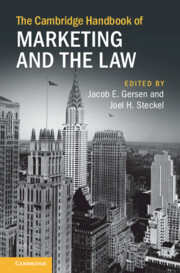Book contents
- The Cambridge Handbook of Marketing and the Law
- The Cambridge Handbook of Marketing and the Law
- Copyright page
- Dedication
- Contents
- Figures
- Tables
- Contributors
- Introduction
- Part I Understanding Consumer Behavior
- Part II Understanding Marketing Phenomena
- Part III Methodological Advances
- 9 Choice Experiments
- 10 Use of Conjoint Analysis in Litigation
- 11 Piece Problems
- 12 Marketing Analysis in Class Certification
- 13 Damages Estimation in Consumer Deception Class Actions
- 14 Taking a Second Look at Secondary Meaning
- 15 Social Media Evidence in Commercial Litigation
- Part IV How the Law Protects
9 - Choice Experiments
Reducing Complexity and Measuring Behavior Rather than Perception
from Part III - Methodological Advances
Published online by Cambridge University Press: 29 June 2023
- The Cambridge Handbook of Marketing and the Law
- The Cambridge Handbook of Marketing and the Law
- Copyright page
- Dedication
- Contents
- Figures
- Tables
- Contributors
- Introduction
- Part I Understanding Consumer Behavior
- Part II Understanding Marketing Phenomena
- Part III Methodological Advances
- 9 Choice Experiments
- 10 Use of Conjoint Analysis in Litigation
- 11 Piece Problems
- 12 Marketing Analysis in Class Certification
- 13 Damages Estimation in Consumer Deception Class Actions
- 14 Taking a Second Look at Secondary Meaning
- 15 Social Media Evidence in Commercial Litigation
- Part IV How the Law Protects
Summary
Surveys in trademark, trade dress, and false advertising cases often focus on liability. For example, in trademark cases, the focus of survey evidence has often been on whether consumers confuse the two marks. Similarly, survey evidence in false advertising cases has focused on whether the at-issue advertising claim misleads or deceives consumers. Surveys that address these issues of alleged confusion or deception measure consumer “perception,” and the results are often the centerpiece of a plaintiff’s liability arguments. While such questions may be central to cases that seek an injunction or aim to prevent the issuance of a new trademark, they are less relevant in questions of impact or injury.
- Type
- Chapter
- Information
- The Cambridge Handbook of Marketing and the Law , pp. 207 - 220Publisher: Cambridge University PressPrint publication year: 2023

